Mac Hacks (30 page)

. Multimedia Hacks
There’s a story, perhaps apocryphal, that upon being offered the
design for the Apple I, an executive at Hewlett-Packard mused that he
couldn’t see a use for a home computer except to store recipes. That comment
is both insightful and shortsighted all at once. Recipe storage is a great
use of a computer, but what the executive missed (because of his lack of
imagination) was the progression of things. Macs can still hold recipes but
they can also hold music, TV shows, and movies. With drives always
increasing in size, your Mac can process and play multimedia files. The
future wasn’t just recipes—the future meant that computers could store and
play anything that could be digitized. This chapter explains some ways to
make your multimedia experience even better.
. Turn Your Mac into a DVR
Just
about every program that shows up on your TV screen is
hiding somewhere on the Internet, but finding them can be tricky. Let your
Mac do the hard work of finding the shows you want to see.
One of the ads currently being shown on cable TV tells of the woes
of a family where more than one person wants to record a show to a DVR.
Apparently the yearnings of various family members to record their own
shows for later viewing is a major source of domestic frustration.
It doesn’t have to be this way. You can bag all the shows you want
to see on your Mac and let the other members of your household war over
whose shows are going to be recorded on the cable box. All you need is a
deliciously focused and easy-to-use program and a BitTorrent
client.
The really neat thing about catching shows on your Mac? Even if you
miss a show, you’re only a few clicks away from seeing the episode on your
computer. In fact, after reading this hack, you’ll discover you can do
more than just catch that single missed episode: you can grab shows
automatically and watch them at your leisure. By now you’re ready to get
started, so let’s jump on in.
This
hack relies on
torrents
, which are
the data part of the BitTorrent peer-to-peer filesharing protocol.
Torrents are a way to access all kinds of digital content, and you can
accomplish everything in this hack in a less straightforward but more
flexible manner with a general-purpose torrent search application.
However, if
all you’re interested in is TV shows, then the
unimaginatively named application TVShows 2 is the way to go. This app
takes the trouble out of torrents, and since it’s free, there’s no
reason not to give it a whirl. To get your copy, point your browser to
this page
and download
the wonder of television-show-grabbing goodness.
While TVShows 2 makes
finding
television
programs easy, it can’t
download
them.
For
that you’ll need a BitTorrent client. TVShows 2
recommends a free client called
Transmission
, but you’re
free to use any client you’re comfortable with. In fact, if you’re
already using another BitTorrent client, TVShows 2 will default to that
client. To install Transmission, simply download it and then click the
downloaded file.
TVShows 2 is different from most of the apps you download.
Instead of getting a
.zip
file or the app, you
get a file named
TVShows.prefPane
.
Double-clicking it results in a dialog box asking for permission to
add a preference pane (
Figure 10-1
).
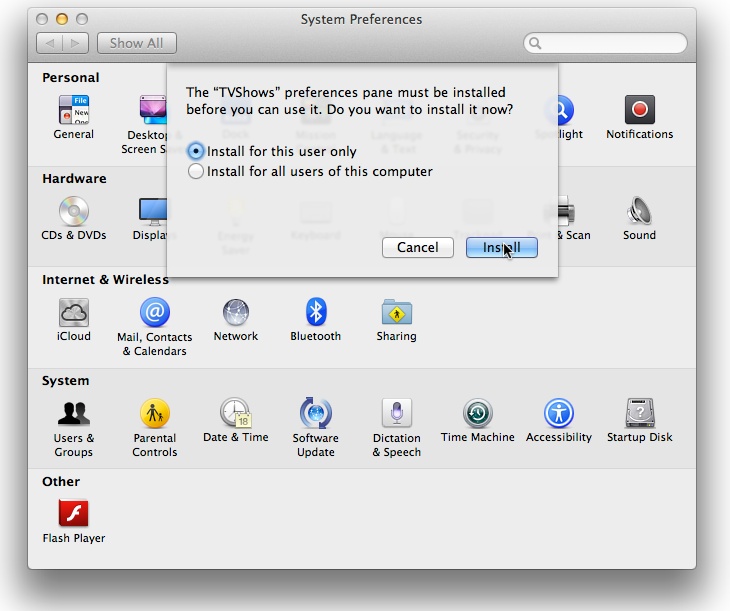
Mac, so go ahead and click Install. Note that you can choose a
system-wide install (“all users”) or single-user install (“this user
only”).
Once you give TVShows 2 permission to add a preference pane, the
System Preferences window will restart and you’ll be treated to the
new TVShows preference pane. Click the pane’s icon and then, in the
program’s window, follow the giant white arrow and click Add Show.
There are tons of them, so filter your options using the search box
(
Figure 10-2
).
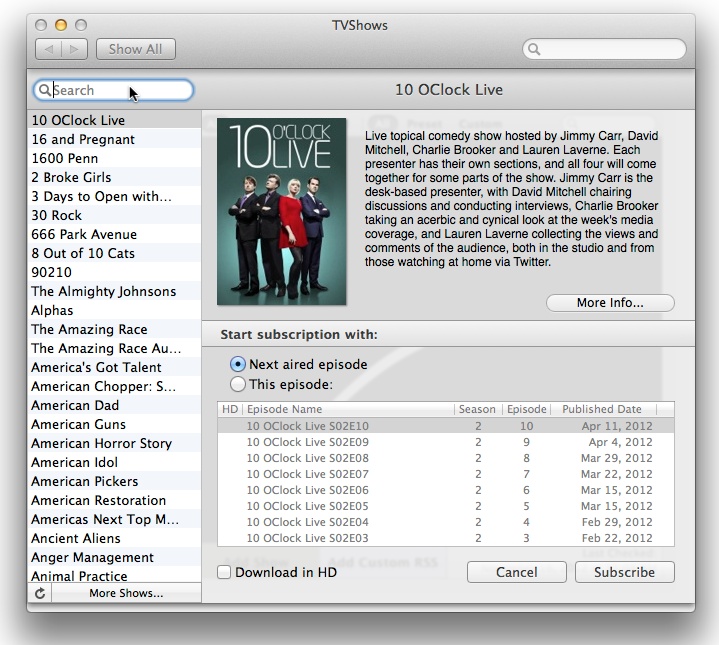
by typing the name of the show in the upper-left corner.
Once you’ve made a selection, your BitTorrent client takes over
and starts downloading the episode you want (
Figure 10-3
). Or, if the
episode you’re after hasn’t aired yet, TVShows 2 will wait patiently
and download the show when it airs.
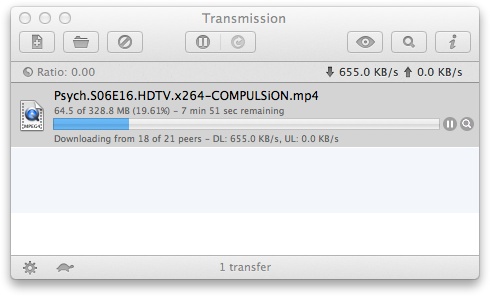
default, the show gets stored in your Downloads folder, something
you’ll want to change if you’re going to be doing this
often.
Note: You don’t explicitly launch or quit TVShows 2. You just
tell it what shows you want via its preference pane, and then it
takes care of the rest.
Downloading a single episode is great and all, but there are
some settings you probably want to change if you plan on using TVShows
2 a bunch. The first thing to consider is the quality of the shows.
(No, not the quality of the shows
themselves
, but
the quality of the file encoding.) As is always the way with these
things, higher quality means longer download times and larger files;
lower quality means quicker downloads and smaller files. Everyone does
the HD thing now, so in the TVShows window, click the Preferences tab
and then turn on the “Download HD versions by default” checkbox. While
you’re there, make your life a little easier by dedicating a folder
for your downloads using the “Episode save location” pop-up menu, and
tell TVShows to make individual folders for each show by checking the
boxes next to “Save each show in its own folder” and “Create season
subfolders.”
Note: High definition can be somewhat hit and miss with some
cable companies. And if you can’t get cable or satellite TV at all
you might find yourself without the HD experience everyone has been
raving about. Fortunately, you can use TVShows 2 to get HD content
wherever you can get broadband. Couple TVShows 2 with a
high-definition TV set or monitor, and you have nearly unlimited HD
content whenever you want it.
Once TVShows 2 tells Transmission to do the downloading thing,
you’re on your way to never-miss-an-episode nirvana. The main problem
you may encounter is that, while some episodes play no problem, others
won’t play on your Mac at all. The
no-problem episodes are
.mp4
files, while the stubborn ones are
.mkv
files.
Don’t worry, there’s a quick fix for this. Head
to
VideoLAN
and download VLC,
an open source media player that will play files that OS X can’t.
(You’ll find yourself using VLC not just for TV shows but also for
other troublesome media in the
future.)
. Master Torrents
Downloading
huge files is easier and speedier with BitTorrent. This
hack explains how to use your Mac to participate in the downloading
fun.
Who can forget Napster, the once-ubiquitous file-sharing program
that made university servers slow to a crawl and ignited the RIAA lawsuit
revolution. Napster is gone but file sharing is still around and more
prevalent (and useful) than ever.
In the standard P2P (peer-to-peer) model, computer A contacts
computer B to download a specified file. The method works fine for
relatively small files like songs but runs into snags when it comes to
larger files. For example, imagine trying to download a 4 GB Linux
distribution from another single user. What happens in that scenario?
First, most ISPs cap upload speed, so if you were to choose someone using
an ISP with a 512 Kbps upload speed cap, you could expect to spend at
least 9 hours downloading the file. Were you to download the same file at
the maximum speed allowed by your ISP, the same download would take a
comparatively short 2 hours (or even less depending on your ISP).
The solution to this problem is obvious now that someone has devised
one: instead of a single client downloading a file from a single host (the
standard manner in which downloads work), what if everyone participated in
both the uploading and downloading of the file? In other words, instead of
the standard client-host relationship, all parties interested in a file
could upload the bits they have on their computer while downloading pieces
of the file they are missing.
The concept sounds nifty, but how can you download just part of a
file? This is where the Internet comes in. As opposed to the P2P model
employed by now-defunct sites like
LimeWire
, the
torrent
model locates easily downloadable bits of the
files out there on the Internet. A BitTorrent client can grab these slices
of files from different sources and knit them together when the download
is complete. So a file is split into an arbitrary number of segments. You
download segments a, b, and c, stitch them together into a complete file
and then share (or
seed
) the file with other
downloaders. In this scenario, everyone shares the burden of bandwidth so
no one person gets stuck with all the overhead.
If that system seems a bit convoluted, that’s because it is. The
preceding description is an idealized version, a near-communistic “from
each according to his abilities, to each according to his needs” deal. The
reality is that BitTorrent has been refined so that the obvious objections
(like “How can I upload anything if I haven’t downloaded anything yet?”)
have been overcome, and the result is a very fast and reliable way to
download large files.
The protocol has proved popular and, according to some estimates,
torrents now comprise a quarter of all web traffic. That shouldn’t be a
surprise. Because torrents are generally used to transfer large files,
downloading a single movie can easily surpass the bit count of all your
other online activities for a single day.
If you’re already using torrents, you (obviously) already have a
torrent client. If you don’t, there are a huge number of choices for OS X,
from the official
BitTorrent
client
to
the well-done
Transmission client
used in the
previous hack. Both are good choices, with the official BitTorrent client
being a little on the sparse side as features go, and Transmission being a
more feature-complete yet still lightweight choice for OS X. That noted,
neither client has that Mac feel that OS X users
demand.
What
would be ideal is a torrent program that looks and acts
like a program made specifically for OS X. Such a client exists: Xtorrent
2, which
manages to make downloading and uploading
seeds
(completed files) painless, understandable, and
controllable. Xtorrent 2 isn’t free, but its cost ($25 for the basic
version) is minimal considering the functionality and usability the
program provides. There’s a free trial version available with some
features removed, so
point your browser to
xtorrent
to get your copy. The trial
copy isn’t obvious, but when you hit Download XTorrent 2, you’ll
automatically download the trial version and be presented with a page
where you can pick your preferred paid version.
Once downloaded, install Xtorrent in your folder of choice (as
always for applications, a good place is the Applications folder). Then
fire up Xtorrent and you’ll be downloading and seeding files in no time
with just a click. Well, after you answer a simple question (see
Figure 10-4
).
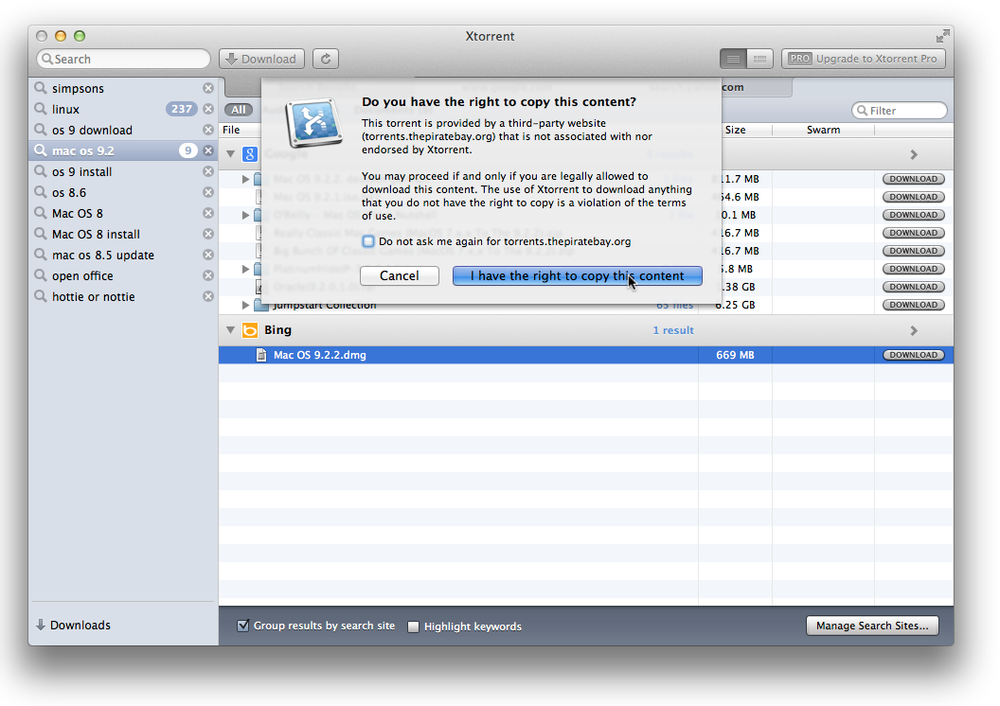
Remember only download the stuff you are allowed to!
Once you’ve assured Xtorrent 2 you are authorized to download the
files, the program will get busy downloading and seeding the files you
desire. But there’s more to Xtorrent 2 than just that. In its main window,
Xtorrent reveals more than just the file’s name and size. You also get
information about the
swarm
, which is torrent speak
for the number of users transferring the files you’re after. This can
include any combination of those offering uploads and those downloading
the files but, generally, the larger the swarm, the more reliable and
faster the download will be.
Xtorrent 2 also allows you to select where your downloads will
reside. To adjust this setting, go to Xtorrent→Preferences, and then click
the Downloads tab. In
Figure 10-5
, the destination is
an automated folder (see
[Hack #22]
) that takes care of
seeing the file to its final destination.
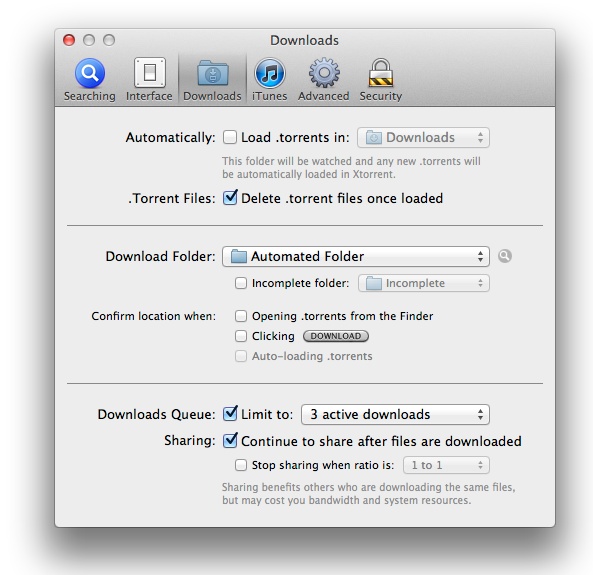
Xtorrent’s preferences. If you’re going to be doing this a lot, you’ll
want to consider automating the destination folder.
Controlling where the files end up is one thing, but depending on
your situation, you might also need
to control the bandwidth allocated for your torrenting purposes. Xtorrent 2 (and most clients)
offer this control. Take another trip to Xtorrent→Preferences, followed by a click on
the Advanced tab. In the Advanced pane, you can set bandwidth limits for
both uploads and downloads, change the port used for “listening” for
torrents, and disable sharing at certain times of the day. What you’ll
most likely want to tweak is the bandwidth limits. The default download
limit is 100 Kbps, and the default upload speed is 20 Kbps. Depending on
the speed of your ISP, you may want to change these settings. For example,
if you have a very speedy connection (you’re a Google Fiber customer,
say), you’ll want to raise the limits. If you have a comparatively pokey
connection, you’ll want to lower the
limits.
Once
you’ve completed a download, you have the full file. Most
of us would call the process complete, but in the torrent world (as
mentioned earlier), a completed file is called a seed. Since someone
generously shared portions of the file and their bandwidth with you, it’s considered good
etiquette to share the completed file with other users for a time.
Xtorrent 2 will take care of the sharing part automatically, so no
worries, but if you’re determined to be a
leech
(torrent speak for a nonsharing jerk),
Xtorrent 2 will allow you to do that, as well. This option is
found under Preferences→Sharing.
There’s a lot more to discover with Xtorrent 2. You can, for
example, use the program as a browser or an RSS reader—particularly nice
features for those addicted to torrents. You’ll discover a huge number of
uses beyond torrents after you use Xtorrent 2 for just a little
while.